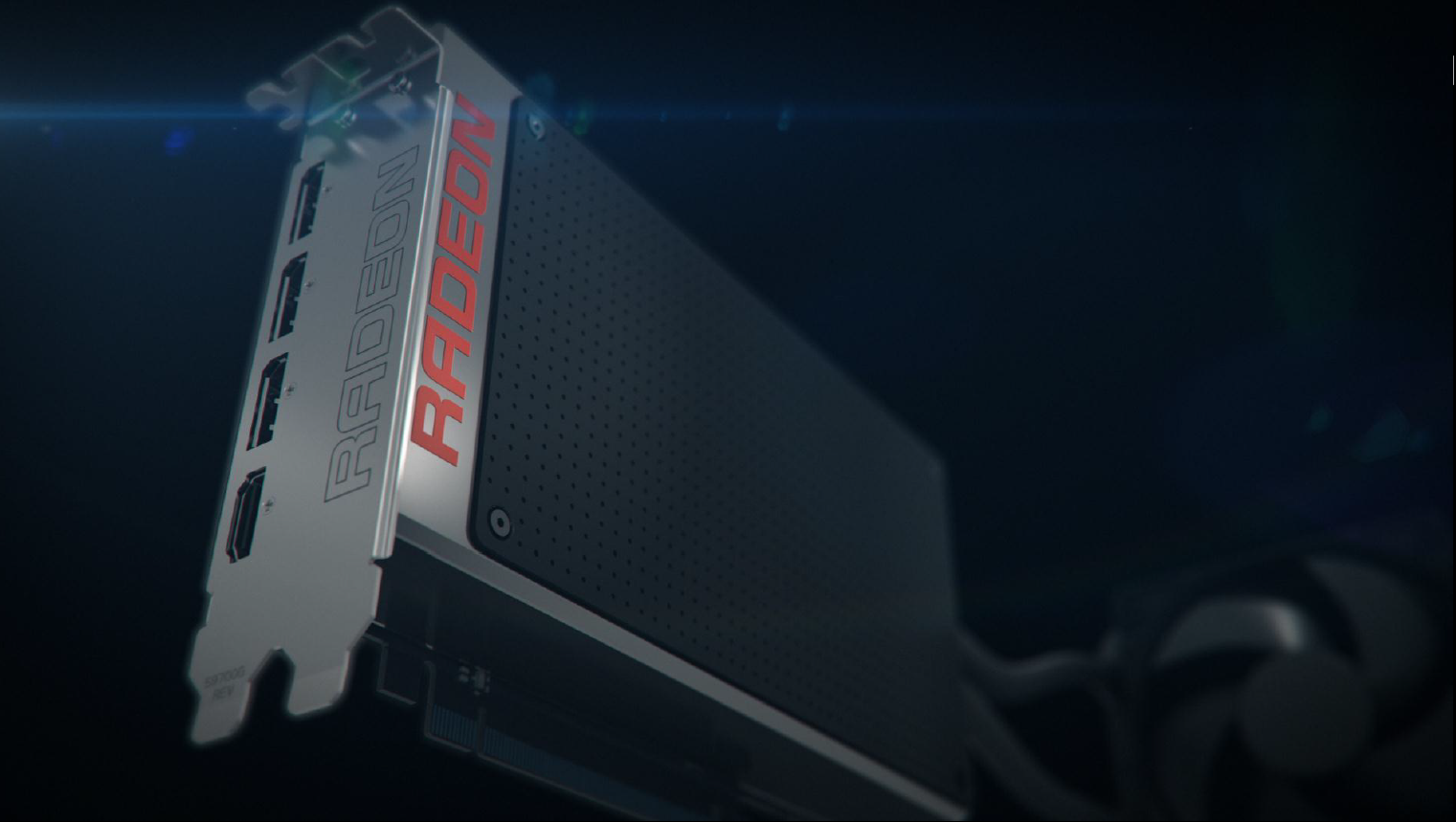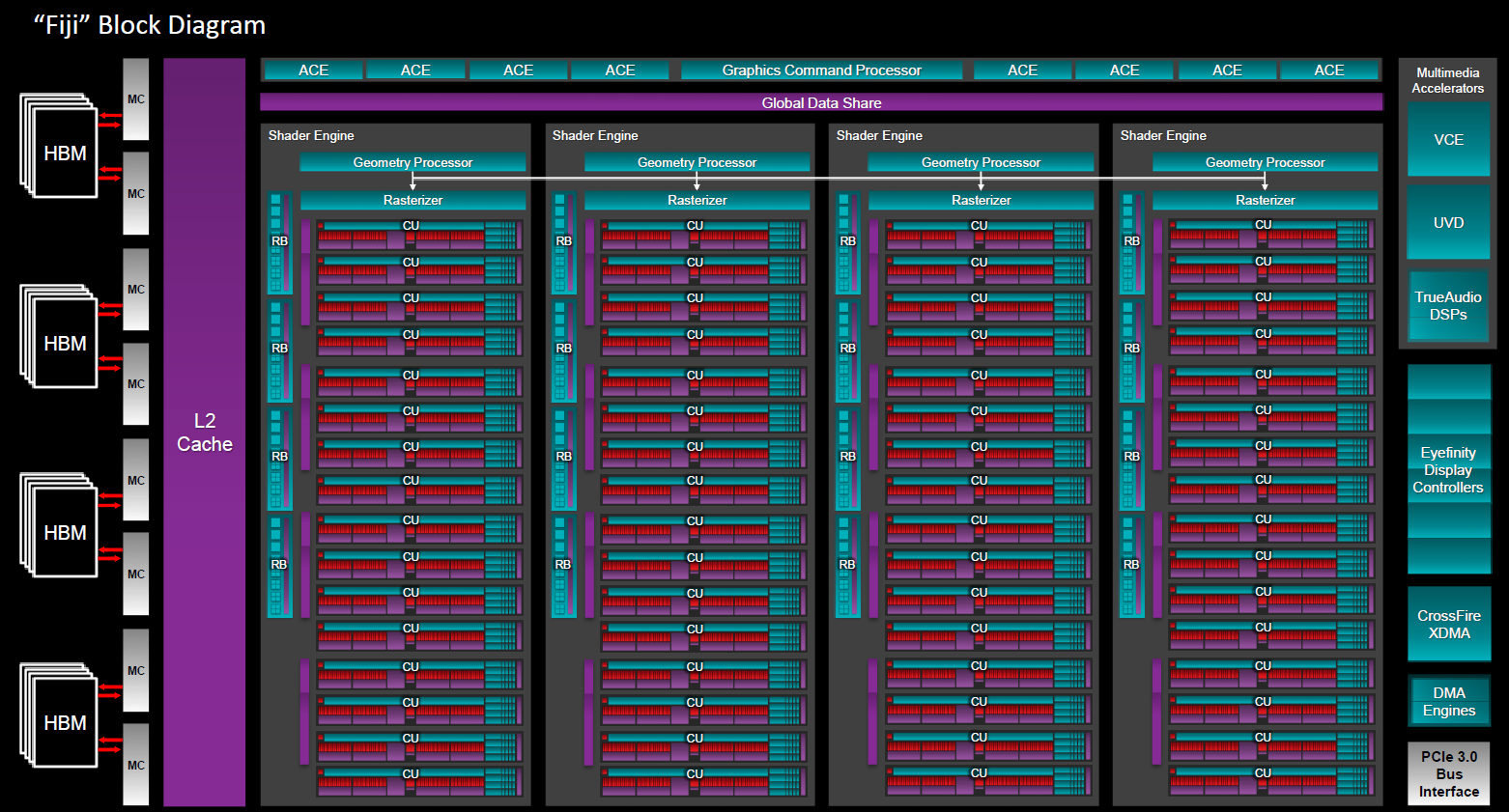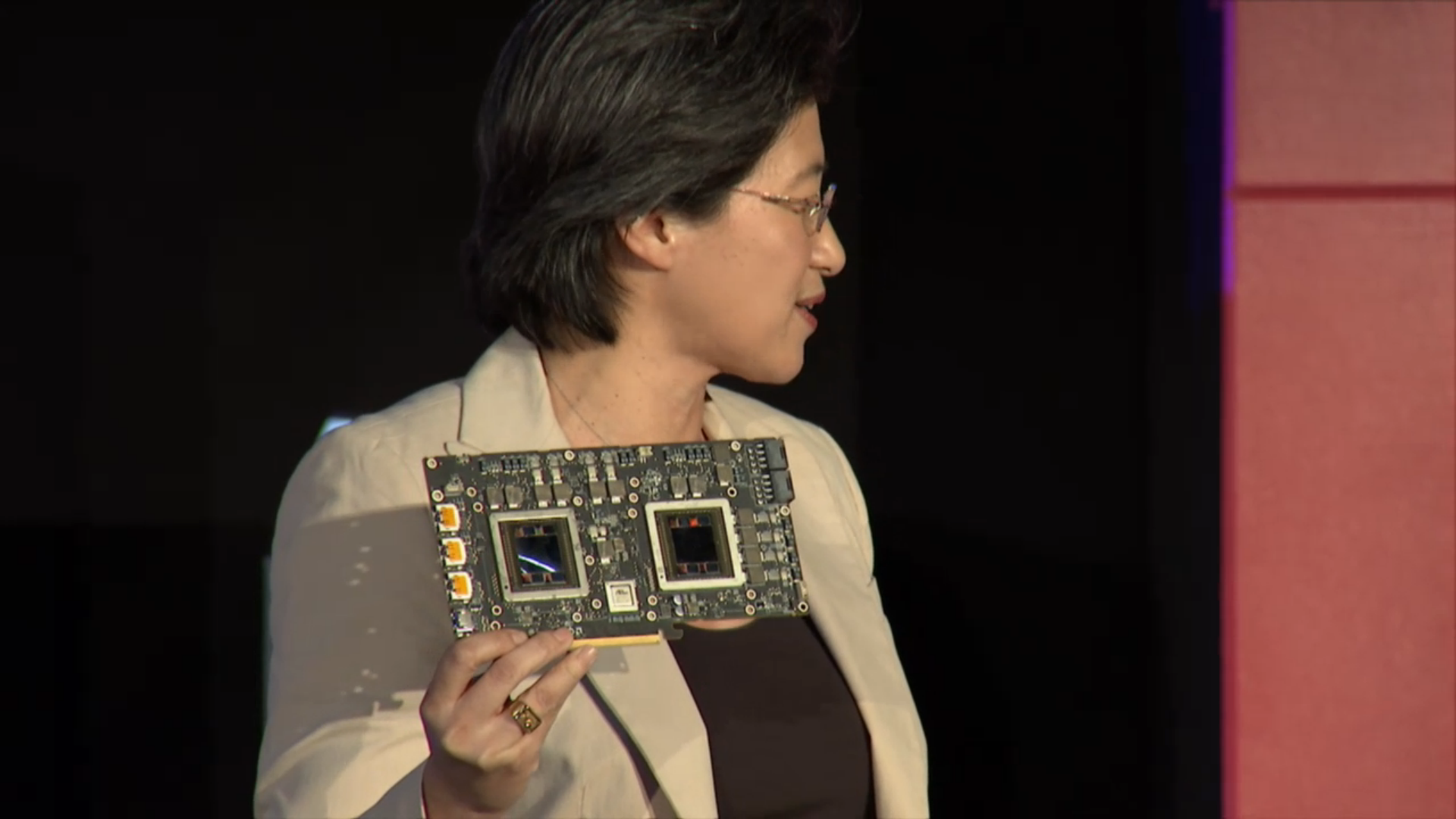AMD Fury X And Fiji Preview
AMD Hawaii GPUs have been powering the company's flagship graphics cards for over 18 months now, and the technology behind it has been around for even longer. The new Fiji GPU is quite different, offering High-Bandwidth Memory (HBM) and a much smaller footprint.
Gaming at 4K demands a lot of graphics performance, which is enabled in part by ample memory bandwidth to keep the GPU busy. Up until a few months ago, the idea of getting reasonable frame rates at 3840 x 2160 almost always required a dual-GPU setup. From what we're told, VR will require similar (if not increased) performance to sustain at least 90 Hz refresh rates for upcoming HMDs. AMD said it expected broader 4K adoption in 2015 and spent the last couple of years readying a graphics processor that could deliver quality gaming at such a high resolution. The company believes Fiji is that solution.
During AMD's E3 press event, it announced nine Radeon cards, including three equipped with Fiji GPUs and High-Bandwidth Memory.
This new approach to graphics memory puts sets of four 256 MB dies stacked directly on a logic die, rather than giving each chip its own logic control. Those stacks are placed next to the GPU die. The complete configuration is attached to a silicon interposer that contains connections between the graphics processor and its memory. The only signals passing through the package substrate are PCI Express, DisplayPort, power, ground and a few test signals, which AMD claims drives cost down compared to more traditional designs.
AMD's HBM operates at much lower clock rates than GDDR, at only 500 MHz DDR, but it communicates across a massive 4096-bit bus. As a result, the top-end Fiji-based card is capable of 512 GB/s of bandwidth, which is as much as 60 percent more than the R9 290X.
Fiji's GPU footprint is 596 mm², which is considerably larger than Hawaii's 438 mm² in Radeon R9 290X. Of course, the 1011 mm² interposer is much larger than Hawaii. However, the 290X also has memory packages taking up a surface area of 110 x 90 mm beyond the GPU itself.
Packed inside Fiji's 596 mm² die are 64 compute units with a combined total of 4096 Stream processors and 256 texture units. The GPU is clocked at 1050 MHz and capable of up to 8.6 TFLOPS of single-precision compute power. Similar to Hawaii, Fiji includes eight Asynchronous Compute Engines that are responsible for real-time and background task scheduling.
Get Tom's Hardware's best news and in-depth reviews, straight to your inbox.
The Cards
AMD says it will launch four Fiji-based graphics cards over the next several months, starting with the R9 Fury X. With planned availability on June 24, the single-GPU flagship should be accompanied by the Radeon R9 Fury in July and the R9 Nano later this summer. A dual-Fiji solution is also expected in the fall.
Contrary to what we've grown accustomed to from ultra high-end graphics cards, this one comes in a compact package. Thanks to its reduced footprint, AMD was able to go from an 11.5-inch-long PCB on the R9 290X down to 7.5 inches.
As you can see, the Fury X doesn't employ a fan on its dual-slot form factor. It instead requires a closed-loop liquid cooler to dissipate its lofty TDP. Without that traditional blower, the company was able to design a fully enclosed, sleek-looking shroud. The card is assembled with multi-piece aluminum construction and soft-touch textured sides. The aluminum exoskeleton features a nickel-plated chrome finish, and the card is accented by an illuminated Radeon logo. The back side of the card is also covered by a matte black plate.
R9 Fury X features a Fiji GPU clocked at 1050 MHz and cooled by liquid in a closed loop. The board features a six-phase power design that was engineered to handle up to 400 A of current. Power through the PCIe slot is supplemented by two 8-pin auxiliary connectors, which combine to deliver up to 375 watts. AMD also includes a feature it calls GPU Tach, a set of LEDs that indicate GPU load and when ZeroCore is active. The Fury X is specified for a 275 W TDP, but AMD says it wanted to leave room for overclocking, so it over-engineered the card's power and cooling.
The liquid cooler is rated for up to 500 watts of cooling capacity, which far exceeds the GPU's needs, allowing for slower fan speeds and quieter operation. In fact, according to company representatives, the fan should generate less than 32 dB, though an AMD product manager claims it will actually run at 28 dB under gaming load. AMD further says to expect temperatures around 50 degrees Celsius in your favorite titles.
The only gaming benchmark that AMD has shown so far is Far Cry 4 on the Fury X at 4K using Ultra settings. Apparently, the card averaged 54 FPS, with a 43 FPS minimum. That's playable, to be sure. However, we don't know anything else about the benchmark itself. We'll be running our own tests of course, as soon as this phantom lands in our lab.
There are no vents on the Fury's rear I/O bracket. Further, you won't find a DVI port. Instead, there are three DisplayPort 1.2 connectors and one HDMI 1.4 output (AMD still doesn't support HDMI 2.0). The Fury X can drive up to six displays simultaneously through a DisplayPort MST hub.
AMD says one of the biggest differences between the Fury X and the rest of the Fury line is that its water-cooled card shouldn't throttle under load (a big issue we identified with the Radeon R9 290X when it first launched). Instead, this board should always run at its highest clock rate. The air-cooled cards, by comparison, are expected to scale back as their heat sinks and fans are saturated with thermal energy.
| Process | 28nm |
|---|---|
| Stream Processors | 4096 |
| Compute Units | 64 |
| Engine Clock | Up to 1050 MHz |
| Compute Performance | 8.6 TFLOPS |
| Texture Units | 256 |
| Texture Fill-Rate | 268.8 GT/s |
| ROPs | 64 |
| Pixel Fill-Rate | 67.2 GP/s |
| Z/Stencil | 256 |
| Memory Configuration | 4 GB HBM |
| Memory Interface | 4096-bit |
| Memory Speed / Data Rate | 500 MHz / 1.0 Gbps |
| Memory Bandwidth | Up to 512 GB/s |
| Power Connectors | 2 x 8-pin |
| Typical Board Power | 275 W |
| PCIe Standard | PCIe 3.0 |
| API Support | DirectX 12, Vulkan, Mantle |
| FreeSync Support | Yes |
| Virtual Super Resolution | Yes |
| Frame Rate Target Control | Yes |
We do know that the standard Fury will feature the same Fiji processor and an air-cooled thermal solution. We can also assume it will throttle back if pushed beyond a certain temperature threshold, unlike the Fury X with its higher-capacity cooler.
The R9 Nano was a big surprise when AMD revealed it. This card features the same GPU, but an even shorter six-inch-long PCB. The smaller card is accompanied by a much lower 175 watt thermal limit and will throttle under taxing workloads. AMD says that compute performance can be as much as 10 percent lower than Fury X, though gaming performance shouldn't be much different. The company posits that R9 Nano offers as much as twice the performance per watt and performance per square millimeter as the R9 290X, though we're waiting on more specific information as to how it reached that figure.
All of the Fiji-based cards support similar features, including support for the latest APIs, Mantle, Vulcan and DirectX 12. AMD seems particularly excited about DX12, stating that the new API will open up even more performance from the cards, with as much as seven times as many draw calls and the ability to share all resources (GPUs, CPUs and memory) more efficiently and with fewer restrictions.
The company's Virtual Super Resolution (VSR) technology allows the GPU to render beyond the displayed resolution. AMD claims this delivers a superior visual experience as textures and models can be rendered at up to 4K and rescaled to fit a lower-resolution display. The company claimed the effect simulates super-sampling anti-aliasing (SSAA) for games with engines that don't support it, and it can display more of the game at once, which could be very useful in RTS games.
Frame Rate Target Control (FRTC) is another new feature that has just been added to the new R9 line-up. FRTC allows you to set a specific frame rate target -- 60 FPS, for example. When playing a game that demands less performance than the GPU has available, the GCN cores will throttle back to whatever rate is needed to reach that level. AMD says that the GPU uses one-third less power with FRTC enabled than it does without, though obviously that figure will depend on the target you choose. Less power means less heat, facilitating slower fan speeds and even quieter operation.
AMD says FreeSync-enabled monitors are fully supported, and FRTC will work with or without a FreeSync display. The company claimed that using its frame syncing technology can actually result in even more power savings, as the GPU doesn't need to work harder than the set limits of the FreeSync range.
There is one other model on the horizon, but there is no name yet for this one. It will feature two Fiji GPUs and will be coming out later this year. Not much has been revealed about that card, though AMD has stated that the dual-GPU cards will have the same thermal limitations as the R9 Nano.
The Radeon R9 Fury X goes on sale June 24 for a suggested price of $649. R9 Fury will follow on July 14 for $549. AMD has not, however, announced pricing or release dates for the Nano and dual-Fiji cards. It promises both later this summer and fall, respectively.
Follow us @tomshardware, on Facebook and on Google+.
Kevin Carbotte is a contributing writer for Tom's Hardware who primarily covers VR and AR hardware. He has been writing for us for more than four years.
-
uroshi Does anyone actually have a 4k 60Hz display without DP1,2? So why the fuss about HDMI 2.0 ...Reply -
revanchrist Fury Nano = 85-90% of Fury XReply
No, this is not speculation. Wccftech claim they're told directly by AMD.
wccftech.com/amd-radeon-r9-nano-detailed-features-fiji-gpu-175w-tdp-single-8pin-connector-sff-design-faster-hawaii/ -
milkod2001 iDid expect proper benchmarks to be all over Internet on DAY 1 of official announcement. It's Day 2 and we still have only lame preview here :(Reply
Don't get me wrong im not blaming Tom's for this, just curious what's taking so long? Availability in 6 days and we still don't know what we are getting. Can AMD get one thing right?
-
Innocent_Bystander ReplyThe air-cooled cards, by comparison, are expected to scale back as their heat sinks and fans are saturated with thermal energy.
I like your style. It's called overheating.
-
srap I am very curious, if this is the Tonga style GCN 1.2 architecture, or they upped it to 1.3; and if so, what changes have been made to it?Reply
Does anyone actually have a 4k 60Hz display without DP1,2? So why the fuss about HDMI 2.0 ...
The people who usually complain are the ones with 4k TVs, not 4k monitors.
And there are the people who complain about the lack of DVI, they are the ones with Korean monitors. -
blackbit75 "From what we're told, VR will require similar (if not more) performance to sustain at least 90 Hz refresh rates for upcoming HMDs"Reply
Just marketing, if not, they will not make VR games on Xbox & PS4 in the future, and it will be made.
In my opinion, if there isn't games yet, it is because games companies sees this technology as a niche, without any successful development yet. More investement to develop games in a market seen as an experiment for them (EA, etc.).
Depends much, much more on the game, than the characteristics of the GPU. Actual mid-high end GPUs could handle actual games in VR to fit 90FPS, just adjusting settings on the game. -
ern88 Well, if VR is going to be that demanding. I won't hop on i till it matures. A R9 390X should be sufficent. If it isn't. I'll let the VR boat sail by!!!Reply -
dave_trimble ReplyThe air-cooled cards, by comparison, are expected to scale back as their heat sinks and fans are saturated with thermal energy.
I like your style. It's called overheating.The air-cooled cards, by comparison, are expected to scale back as their heat sinks and fans are saturated with thermal energy.
I like your style. It's called overheating.The air-cooled cards, by comparison, are expected to scale back as their heat sinks and fans are saturated with thermal energy.
I like your style. It's called overheating.
I like your style. Do you also describe Nvidia cards, which throttle in exactly the same way when they reach their temperature threshold, as overheating? Or are you equally pedantic across all brands?



